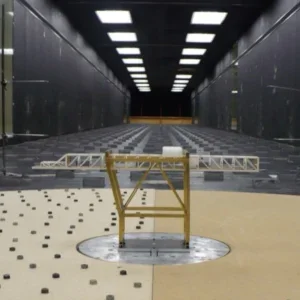In the ideal world, every load will have purpose designed lifting points to which lifting slings can easily be attached by hook or shackle. In the real world, many items which have to be lifted do not have such lifting points and they are rarely a convenient shape. Sometimes this is due to lack of forethought by the designer. Equally, the item may be part of an assembly which was previously lifted as a whole or conversely it may be an assembly of components each of which was previously lifted separately during building of the assembly.
In the latter case, care is needed to check whether any lifting points are adequate for the whole assembly or just the individual component. A typical example is a motor and pump on a bed plate. There may be an eyebolt hole in the motor and another in the pump, each adequate for its respective component but together not adequate for the whole assembly.
Similarly the top half of a large gearbox may have lifting points, but they are probably just for lifting the top, not the whole gearbox.
In the absence of suitable lifting points, the main options are to attach slings by passing them through or around the load. Passing through a suitable aperture has the advantage of making the load captive but care is needed to ensure that the material around the aperture is strong enough to take the whole load. Passing around the load has the advantage of giving the load better support by cradling it, but care is needed to ensure it is securely attached and cannot slip or fall out.
Other aspects of the load to consider are whether it is flexible, in one piece or needs holding together, is vulnerable to local damage or has to be manipulated in the air. It is worth stressing the need to consider at the planning stage the position and security of the method of attachment through all the stages of manipulation.
Flexible loads, or loads which are delicate, may need support at several positions and require a means of adjusting the sling length at each support point. If relying on slings alone to lift a flexible load, remember that as the angle of the sling leg to the vertical increases, so does the inward force tending to crush the load. A lifting beam can provide multiple support points without a crushing force. In the extreme case, a delicate load may require a rigid supporting cradle placed underneath it to withstand the lifting forces.
A typical example of a load which needs holding together is a bundle of long slender items such as reinforcing rod and tubes. Sometimes they are secured by steel or plastic banding but caution is needed as the banding may not hold adequately during a lift. Far better to ensure that the sling secures the bundle. The normal method is to wrap the sling around the load in choke hitch. I think it probable that every guide to slinging I have ever seen includes the admonishment not to batten down the choke. However, if you stand awhile at a construction site, you are likely to see someone rig the choke then pick up a lump of wood or a scaffold pole and wallop the sling to tighten it. It is a dangerous practice and there is a much better method.
Left alone, a choke hitch will adjust itself so that at the point of choke, the three parts of the sling are at 120 degrees to each other. However that leaves the items at the top of the bundle loose, hence the misguided attempt to tighten the choke. But, no matter how much force is used, this method will never secure every item. The two parts of the sling below the choke are akin to the legs of a two leg sling. The wider they are apart, the greater the force in them. To secure every item, they would have to be at 180 degrees and the force would be infinite. Battening down the choke simply risks breaking the sling. The answer is to wrap the sling a full turn around the load before making the choke, a wrap and choke hitch. That secures the whole bundle.
A wrap and choke also grips a load better than a simple choke. This is helpful in several situations. Whether lifting a bundle or a single item such as a steel beam, if a two leg sling is attached using choke hitch, you need to be confident that one or both legs will not slide inwards on lifting. Similarly, there are applications where it is necessary to lift a long slender item with a single sling leg. If attached exactly central, the load is likely to rock uncontrollably in the air. By deliberately offsetting the attachment point, it will lift at an angle and will remain stable in the air but again relies upon adequate grip to prevent slipping. When used with the appropriate type of sling, a wrap and choke hitch can provide the grip needed.
Many loads are vulnerable to local damage and need protecting. Sometimes the pressure from a sling is sufficient to cause local indentation or damage to the surface finish. Generally, textile slings are less likely to cause local damage than wire rope or chain slings. Round slings flatten under load thus reducing the pressure. A greater spread can be achieved with webbing slings but particular care is required to ensure they are uniformly loaded across their width. If a webbing sling is used around a corner of a load and inclined to one side, all the force will be imposed on the outer edge of the webbing. This will negate the advantage of the webbing sling, causing damage to the load. Even worse, it can overload the edge of the webbing and cause it to tear. Once the tear has been initiated, it is likely to continue across the diminishing section of webbing resulting in catastrophic failure. A lifting beam or spreader used in conjunction with a webbing sling will facilitate correct uniform loading. When attaching to the base of a delicate load it can also keep the slings clear of the sides of the load.
Another method of attachment is basket hitch. This has relatively few applications as it provides very little grip to prevent the sling sliding along a load. Hence a single leg basket hitch should only be used if the sling is passed through the load making it captive. Multi-leg basket lift is generally only suitable if the shape of the load is such as to prevent the legs sliding inwards. It does have the potential advantage that a sling can have a higher rating in basket hitch than in straight pull or choke hitch.
I have mentioned the need to adjust the sling length to achieve the required geometry. There are several ways to achieve this. Chain slings can be fitted with a chain clutch or shortening hook which facilitates very large adjustments but only to the nearest link length and the adjustment must be made with the chain slack. Turnbuckles facilitate relatively short adjustments but with great accuracy. A lever hoist can be used within a sling arrangement and, although relatively bulky, it provides easy adjustment in the air with considerable accuracy. It can be used inverted to climb its chain, thus keeping the lever within reach of the slinger.
There are also a few other tricks which can be used in certain circumstances. An extra shackle or link can make a step change in length. An extra wrap around a load can take up excessive length of a sling. All slings need packing to protect them from sharp edges, particularly textile slings. Packing is also often needed to protect the load. Adjustments in the packing can be used to make small changes in length.
Very often the best slinging solution is found by combining slings and accessories to take advantage of the best properties of each. I have already mentioned the use of lifting beams and spreaders. Another example is using a pair of round slings in wrap and choke to connect to a load, then hooking a two leg chain sling with shortening clutches into them. The round slings provide the secure connection and the chain sling provides the adjustment.
Taken further, it is possible that an eyebolt or swivel link provides one connection to the load, a round sling in choke sling provides another, an adjustable chain sling hooks into one and, for fine adjustment, a lever hoist hooks into the other.
One combination best avoided is where one leg of an arrangement employs only a textile sling and another only a metallic sling. Textile slings stretch to a greater extent under load than metallic slings and this can lead to some difficulties. Hence the general recommendation is to avoid combining in that way.
In a short article I can only touch on a limited part of a big subject. What I hope the above illustrates is the need to have available a good selection of slings, accessories and other lifting equipment and to be familiar with the particular attributes of each item. Obviously when selecting equipment, its capacity is of prime importance. However, by taking advantage of those particular attributes and combining them imaginatively, the optimum solutions can be found.






